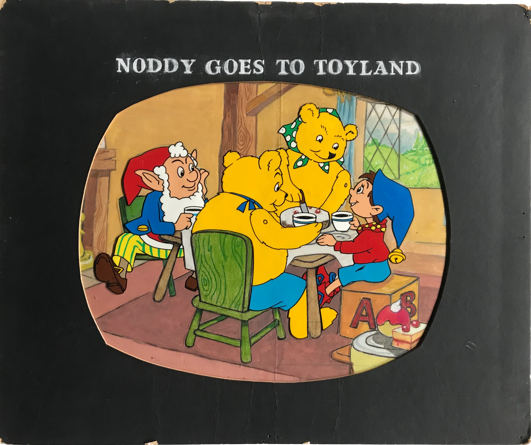When our late father, Arthur Humberstone, died on the eve of the millennium, we did not anticipate that we were to inherit a historical animation archive. It was ordinary everyday life for us to pass the door of his pencil-scented home studio and observe him sat at his angled light box desk—drawing, sketching, and flipping his hand-drawn animations. We didn’t know any different and never truly comprehended the significance of the reams of drawings, storyboards, painted cels, sketches, and associated memorabilia that lay stacked on the metal shelving in his room.
If, like myself, you believe that the essence of any work produced is contained within its production methods, then archives like these are invaluable and need to be preserved to document and tell the wider picture of animation history.

From starting relatively late in life as a trainee at G.B Animation’s Moor Hall facility, Arthur Humberstone went on to become a prolific animator. He had worked well beyond retirement into the late 1980s, by which point computer animation, the digital successor to frame-by-frame animation, had started to influence the way animated films were made. As a proponent of old school animation methods, he must have felt a sense of redundancy as his career finished, and it is a wonder he kept hold of so much archive material. For us, it was not immediately obvious what lay within the seemingly meaningless piles of paperwork, its relevance, or why it should be preserved. Who would have known that an animator (like our father), who was involved with such a landmark production as England’s first animated feature Animal Farm (1954, dir. John Halas and Joy Batchelor), had saved such a wealth of animation ephemera. In my father’s collection, there are transient items like work charts, scene synopsis, monthly progress reports (including output, bonus system, and timekeeping), so-called daily ‘sweatbox notes’ along with a visually rich collection from Watership Down (1976-1978) including interoffice memorandums, the likes of which help detail the inner workings of an animated feature production. Why someone would actively choose to retain items like progress reports is a mystery but, for enthusiasts and researchers, we are richer as a result.

As I have mentioned, it is a wonder that this archive survives–for one particular project, the 10-minute Noddy Goes to Toyland (1963, dir. Arthur Humberstone), the contract stated that on completion “all physical material prepared and used in the making of the pilot film and the main titling including all backgrounds, cels, artwork, sound-track recordings, music recordings, and other such materials” be returned. Luckily our father retained various pieces–largely as a keepsake of his passionate, hard work–otherwise, there would very little to document this moment in animation.
Other hidden gems include rare painted cels from the early production Nasrudin, Richard William’s ill-fated animated fantasy which later became The Thief and the Cobbler (1993). These materials demand further verification and research as do the almost 200 TV and cinema adverts, educational and short films that our father was involved with during his career.
Only in retrospect, and with the value of hindsight, do we appreciate what has been saved and we are keen to preserve, protect and share it as best we can. Gaumont British Animation, established at Moor Hall, Berkshire, in 1946, remains largely undocumented. However, archive materials allow bringing to life the facility as a fascinating forerunner that helped feed the burgeoning British animation industry with a wealth of writers, background artists, animators, painters, editors, and camera technicians. Plans are underway to secure funding that will allow us to properly digitize and make the collection available for researchers and enthusiasts alike.
Nigel Humberstone is a film music composer and founding member of In The Nursery, the Sheffield-based band who has released more than 30 albums since 1981 with music featured in numerous film soundtracks and theatrical trailers. He and his twin brother Klive are currently cataloging and looking at ways to preserve the archive of their late father (Arthur Humberstone) whose credits include Animal Farm, Yellow Submarine, Watership Down, The Plague Dogs, and The BFG.

3D, Vfx animation services